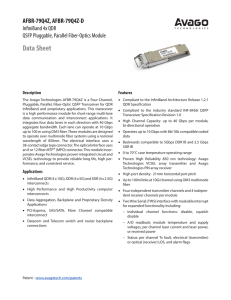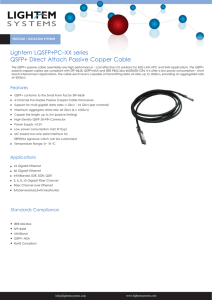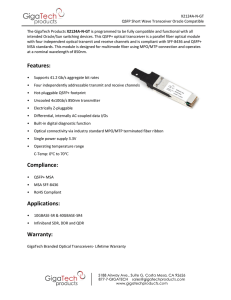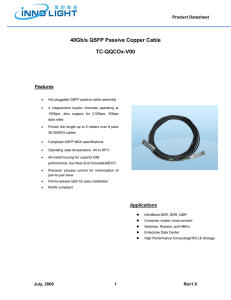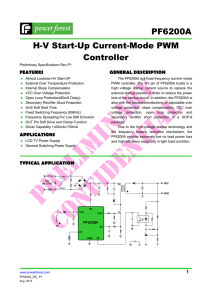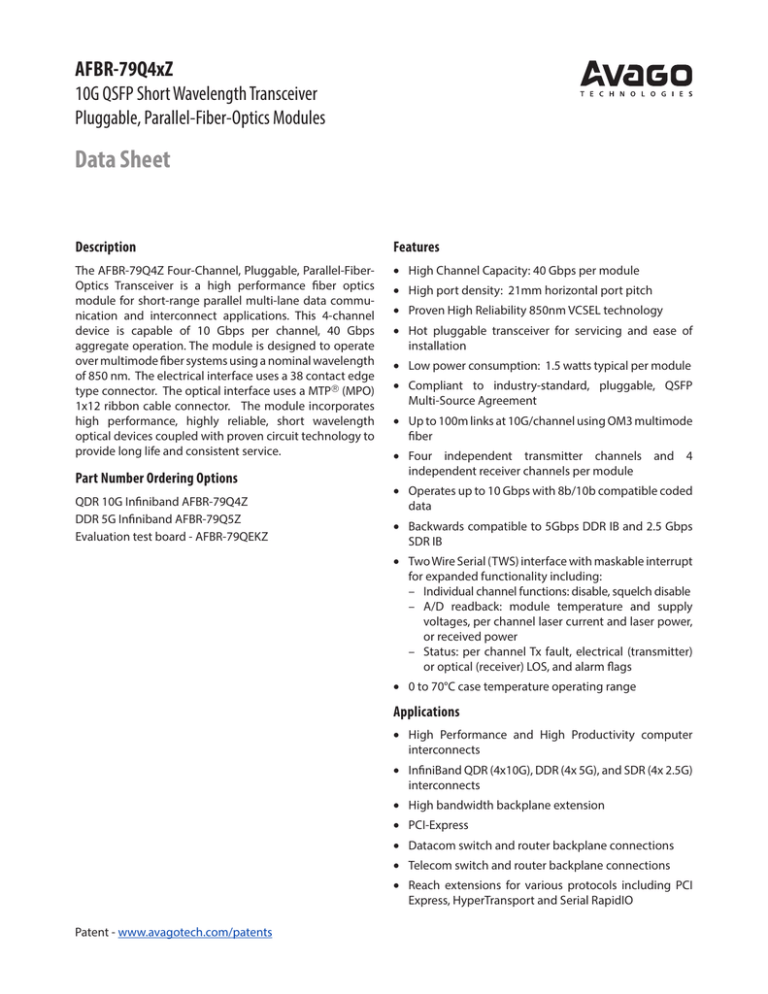
AFBR-79Q4xZ
10G QSFP Short Wavelength Transceiver
Pluggable, Parallel-Fiber-Optics Modules
Data Sheet
Description
Features
The AFBR-79Q4Z Four-Channel, Pluggable, Parallel-FiberOptics Transceiver is a high performance fiber optics
module for short-range parallel multi-lane data communication and interconnect applications. This 4-channel
device is capable of 10 Gbps per channel, 40 Gbps
aggregate operation. The module is designed to operate
over multimode fiber systems using a nominal wavelength
of 850 nm. The electrical interface uses a 38 contact edge
type connector. The optical interface uses a MTP (MPO)
1x12 ribbon cable connector. The module incorporates
high performance, highly reliable, short wavelength
optical devices coupled with proven circuit technology to
provide long life and consistent service.
• High Channel Capacity: 40 Gbps per module
Part Number Ordering Options
QDR 10G Infiniband AFBR-79Q4Z
DDR 5G Infiniband AFBR-79Q5Z
Evaluation test board - AFBR-79QEKZ
• High port density: 21mm horizontal port pitch
• Proven High Reliability 850nm VCSEL technology
• Hot pluggable transceiver for servicing and ease of
installation
• Low power consumption: 1.5 watts typical per module
• Compliant to industry-standard, pluggable, QSFP
Multi-Source Agreement
• Up to 100m links at 10G/channel using OM3 multimode
fiber
• Four independent transmitter channels and 4
independent receiver channels per module
• Operates up to 10 Gbps with 8b/10b compatible coded
data
• Backwards compatible to 5Gbps DDR IB and 2.5 Gbps
SDR IB
• Two Wire Serial (TWS) interface with maskable interrupt
for expanded functionality including:
– Individual channel functions: disable, squelch disable
– A/D readback: module temperature and supply
voltages, per channel laser current and laser power,
or received power
– Status: per channel Tx fault, electrical (transmitter)
or optical (receiver) LOS, and alarm flags
• 0 to 70°C case temperature operating range
Applications
• High Performance and High Productivity computer
interconnects
• InfiniBand QDR (4x10G), DDR (4x 5G), and SDR (4x 2.5G)
interconnects
• High bandwidth backplane extension
• PCI-Express
• Datacom switch and router backplane connections
• Telecom switch and router backplane connections
• Reach extensions for various protocols including PCI
Express, HyperTransport and Serial RapidIO
Patent - www.avagotech.com/patents
TX Input Buffer
4 Channels
Laser Driver
4 Channels
Control
Diagnostic
Monitors
Dout[3:0][p/n] (8)
RX Output Buffer
4 Channels
TIA
4 Channels
Optical Interface
SCL
SDA
Mod Sel
LPMode
ModPresL
ResetL
IntL
1x4 PIN Array
Electrical Interface
1x4 VCSEL Array
Din[3:0][p/n] (8)
Figure 1. Transceiver Block Diagram
Transmitter
Receiver
The optical transmitter portion of the transceiver (see
Figure 1) incorporates a 4-channel VCSEL (Vertical Cavity
Surface Emitting Laser) array, a 4-channel input buffer and
laser driver, diagnostic monitors, control and bias blocks.
The transmitter is designed for IEC-60825 and CDRH eye
safety compliance; Class 1M out of the module. The Tx
Input Buffer provides CML compatible differential inputs
presenting a nominal differential input impedance of
100 Ohms. AC coupling capacitors are located inside the
QSFP module and are not required on the host board. For
module control and interrogation, the control interface
(LVTTL compatible) incorporates a Two Wire Serial (TWS)
interface of clock and data signals. Diagnostic monitors
for VCSEL bias, light output (LOP), temperature, and power
supply voltage are implemented and results are available
through the TWS interface.
The optical receiver portion of the transceiver (see Figure 1)
incorporates a 4-channel PIN photodiode array, a 4-channel
TIA array, a 4 channel output buffer, diagnostic monitors,
control and bias blocks. The Rx Output Buffer provides CML
compatible differential outputs for the high speed electrical interface presenting nominal single-ended output impedances of 50 Ohms to AC ground and 100 Ohms differentially that should be differentially terminated with 100
Ohms. AC coupling capacitors are located inside the QSFP
module and are not required on the host board. Diagnostic
monitors for optical input power, are implemented and
results are available through the TWS interface.
Alarm thresholds are established for the monitored attributes. Flags are set and interrupts generated when the
attributes are outside the thresholds. Flags are also set
and interrupts generated for loss of input signal (LOS) and
transmitter fault conditions. All flags are latched and will
remain set even if the condition initiating the latch clears
and operation resumes. All interrupts can be masked and
flags are reset by reading the appropriate flag register.
The optical output will squelch for loss of input signal
unless squelch is disabled. Fault detection or channel
deactivation through the TWS interface will disable the
channel. Status, alarm and fault information are available
via the TWS interface. To reduce the need for polling, the
hardware interrupt signal is provided to inform hosts of an
assertion of an alarm, LOS and/or Tx fault.
2
Alarm thresholds are established for the monitored
attributes. Flags are set and interrupts generated when
the attributes are outside the thresholds. Flags are also
set and interrupts generated for loss of optical input
signal (LOS). All flags are latched and will remain set even
if the condition initiating the latch clears and operation
resumes. All interrupts can be masked and flags are reset
upon reading the appropriate flag register. The electrical output will squelch for loss of input signal (unless
squelch is disabled) and channel de-activation through
TWS interface. Status and alarm information are available
via the TWS interface. To reduce the need for polling, the
hardware interrupt signal is provided to inform hosts of an
assertion of an alarm and/or LOS.
High Speed Signal Interface
Figure 2 shows the interface between an ASIC/SerDes
and the QSFP module. For simplicity, only one channel is
shown. As shown in the Figure 2, the compliance points
are on the host board side of the electrical connectors.
Unused inputs and outputs should be terminated with
100 Ω differential loads.
Host Board
(Only one channel shown for simplicity)
A
B'
Rx Out p
Rx Out n
Rx
QSFP Module
Tx In p
Tx In n Tx
Optical Connector/Port
(Optical Interface)
ASIC (SerDes)
Module Card Edge
(Host Interface)
C'
Host Edge Card Connector
C
D
B
Rx 1
Rx 2
Rx 3
Rx 4
Tx 4
Tx 3
Tx 2
Tx 1
Figure 2. Application Reference Diagram
QSFP compliance and reference points are as follows:
Package Outline
A: Host ASIC transmitter output at ASIC package contact
on a DUT board – Reference point
The module is designed to meet the package outline
defined in the QSFP MSA. See the package outline and
host board footprint figures (Figures 11 -13) for details.
B: Host ASIC transmitter output across the Host Board and
Host Edge Card connector at the Module
Card Edge interface – Reference point
B’: Host ASIC transmitter output across the Host Board at
Host Edge Card Connector – Compliance point
C: QSFP receiver output at the Module Card Edge Interface
– Reference point
C’: QSFP receiver output at Host Edge Card Connector –
Compliance point
D: QSFP receiver output at Host ASIC package receiver
input contact on a DUT board – Reference point
Control Signal Interface
The module has the following low speed signals for
control and status: ModSelL, LP Mode, ResetL, ModPrsL,
IntL In addition, there is an industry standard two wire
serial interface scaled for 3.3 volt LVTTL. It is implemented as a slave device. Signal and timing characteristics
are further defined in the Control Characteristics and
Control Interface & Memory Map sections. The registers
of the serial interface memory are defined in the Control
Interface & Memory Map section.
Regulatory & Compliance Issues
Various standard and regulations apply to the modules.
These include eye-safety, EMC, ESD and RoHS. See the Regulatory Section for details regarding these and component
recognition. Please note the transmitter module is a Class
1M laser product – DO NOT VIEW RADIATION DIRECTLY
WITH OPTICAL INSTRUMENTS. See Regulatory Compliance
Table for details. When released, the AFBR-79Q4Z and
AFBR-79Q5Z will support this table.
3
Handling and Cleaning
The transceiver module can be damaged by exposure to
current surges and over voltage events. Care should be taken
to restrict exposure to the conditions defined in the Absolute
Maximum Ratings. Wave soldering, reflow soldering and/or
aqueous wash process with the modules on board are not
recommended. Normal handling precautions for electrostatic discharge sensitive devices should be observed.
Each module is supplied with an inserted port plug for
protection of the optical ports. This plug should always be
in place whenever a fiber cable is not inserted.
The optical connector includes recessed elements that
are exposed whenever a cable or port plug is not inserted.
Prior to insertion of a fiber optic cable, it is recommended
that the cable end be cleaned to avoid contamination
from the cable plug. The port plug ensures the optics
remain clean and no addition cleaning should be needed.
In the event of contamination, dry nitrogen or clean dry
air at less than 20 psi can be used to dislodge the contamination. The optical port features (e.g. guide pins) preclude
use of a solid instrument. Liquids are also not advised.
Link Model and Reference Channel
Performance specifications for the AFBR-79Q4Z Transceiver
are based on a reference channel model. A reference
channel model provides the basis for inter-operability
between independently produced transceiver modules.
The reference model used for the AFBR-79Q4Z Transceiver is based on the industry standard 10GbE link model
(10GEPBud3_1_16a.xls available at the IEEE P802.3ae
10Gb/s Ethernet Task Force Serial PMD Documents
website:
www.ieee802.org/3/ae/public/adhoc/serial_
pmd/documents/)
Absolute Maximum Ratings
Stress in excess of any of the individual Absolute Maximum Ratings can cause immediate catastrophic damage to the
module even if all other parameters are within Recommended Operation Conditions. It should not be assumed that
limiting values of more than one parameter can be applied to the module concurrently. Exposure to any of the Absolute
Maximum Ratings for extended periods can adversely affect reliability.
Parameter
Symbol
Min
Max
Units
Storage Temperature
TS
-40
100
°C
Case Temperature – Operating
TC AMR
0
70
°C
3.3 V Power Supply Voltage
VCC
-0.5
3.6
V
-0.5
VCC+0.5
V
1.0
V
Data Input Voltage – Single Ended
Data Input Voltage – Differential
|VDIP - VDIN|
Control Input Voltage
Vi
-0.5
VCC+0.5, 3.6
V
Control Output Current
Io
-20
20
mA
Relative Humidity
RH
5
95
%
Reference
1
2
1. The position for case temperature measurement is shown in Figure 5.
2. This is the maximum voltage that can be applied across the differential inputs without damaging the input circuitry. The equivalent input
differential peak-to-peak voltage is twice this number.
Recommended Operating Conditions
Recommended Operating Conditions specify parameters for which the optical and electrical characteristics hold
unless otherwise noted. Optical and electrical characteristics are not defined for operation outside the Recommended Operating Conditions, reliability is not implied and damage to the module may occur for such operation over an
extended period of time.
Parameter
Symbol
Min
Typ
Max
Units
Reference
Case Temperature
Tc
0
40
70
°C
1
3.3 V Power Supply Voltage
Vcc
3.135
3.3
3.465
V
2.5
10.0
GBd
Signal Rate per Channel
Control* Input Voltage High
Vih
2
Vcc+.3
V
Control* Input Voltage Low
Vil
-0.3
0.8
V
Two Wire Serial (TWS) Interface Clock Rate
400
kHz
TWS Write Cycle Time
40
ms
Power Supply Noise
50
mVpp
Receiver Differential Data Output Load
100
2
3
Ohms
Fiber Length: 500 MHz∙km 50µm MMF (OM2)
0.5
35
m
Fiber Length: 2000 MHz∙km 50µm MMF (OM3)
0.5
100
m
4
* Control signals, LVTTL (3.3 V) compatible
1. The position of case temperature measurement is shown in Figure 5.
2. 8b10b coding is assumed
3. Power Supply Noise is defined as the peak-to-peak noise amplitude over the frequency range at the host supply side of the recommended power
supply filter with the module and recommended filter in place. Voltage levels including peak-to-peak noise are limited to the recommended
operating range of the associated power supply. See Figure 6 for recommended power supply filter.
4. Channel insertion loss includes 3.5 dB/km attenuation, 1.5 dB connector loss and 0.3 dB modal noise penalty allocations.
4
Transceiver Electrical Characteristics*
The following characteristics are defined over the Recommended Operating Conditions unless otherwise noted. Typical
values are for Tc = 40˚C, Vcc = 3.3 V
Parameter
Typ
Max
Units
10G Transceiver Power Consumption
1.5
TBD
W
5G Transceiver Power Consumption
1.3
TBD
W
10G Transceiver Power Supply Current
454
TBD
mA
5G Transceiver Power Supply Current
394
TBD
mA
2000
ms
Transceiver Power On Initialization Time
Symbols
Min
tPWR INIT
Reference
1
1. Power On Initialization Time is the time from when the supply voltages reach and remain above the minimum Recommended Operating Conditions
to the time when the module enables TWS access. The module at that point is fully functional.
Transmitter Section Electrical Characteristics*
The following characteristics are defined over the Recommended Operating Conditions unless otherwise noted. Typical
values are for Tc = 40˚C, Vcc = 3.3 V
Parameter
Symbols
LOS Assert Threshold:
Tx Data Input Differential
Peak-to-Peak Voltage Swing
ΔVdi pp los
Max
Units
50
mVpp
0.5
4
dB
1
175
1600
mVpp
2
30
48
ps
Data Input Deterministic Jitter
15
ps
3
Data Input Total Jitter
30
ps
4
LOS Hysteresis: Tx Data Input
Min
Typ
Reference
Test conditions for Optical Tx Characteristics:
Data Input Differential
Peak-to-Peak Voltage Swing
Data Input Rise & Fall Times (20% – 80%)
ΔVDI pp
* For control signal timing including MODSelL, LPMode, ResetL, ModPrsL, IntL, SCL and SDA see Control Interface and Memory Map.
1. LOS Hysteresis is defined as 20 Log(LOS De-assert Level / LOS Assert Level).
2. This is a test condition and is not a required characteristic of the transceiver. It is a Tx Recommended Operating condition. Data inputs are CML
compatible. Data Input Differential Peak to Peak Voltage Swing is defined as follows: ΔVDI pp = ΔVDIH – ΔVDIL where ΔVDIH = High State Differential
Data Input Voltage and ΔVDIL = Low State Differential Data Input Voltage.
3. This is a test condition and is not a required characteristic of the transceiver. It is a Tx Recommended Operating condition. Deterministic Jitter, DJ,
conforms to the dual-Dirac model where TJ(BER) = DJ + 2Q(BER)RJrms and RJrms is the width of the Gaussian component. Here BER = 10-12. DJ is
measured with the same conditions as TJ. Effects of impairments in the test signal due to the test system are removed from the measurement. All
channels not under test are operating with similar test patterns.
4. This is a test condition and is not a required characteristic of the transceiver. It is a Tx Recommended Operating condition. Total Jitter, TJ, defined
for a BER of 10-12, is measured at the 50% signal level using using a 10.0 GBd Pseudo Random Bit Sequence of length 27-1 (PRBS7), or equivalent,
test pattern .Effects of impairments in the test signals due to the test system are removed from the measurement. All channels not under test are
operating with similar test patterns.
5
Receiver Section Electrical Characteristics
The following characteristics are defined over the Recommended Operating Conditions unless otherwise noted. Typical
values are for Tc = 40˚C, Vcc = 3.3 V
Parameter
Symbol
Max
Units
Reference
875
mVpp
1
Output Rise/Fall time (20–80%)
55
ps
2
Reference Link Output Deterministic Jitter
36
ps
3
Reference Link Output Total Jitter
70
ps
4
ps
5
Data Output Differential Peak-to-Peak Voltage ΔVDO PP
Swing (Zero De-emphasis)
Reference Link Output Eye Width
tEYE LINK
Min
Typ
375
30
1. Data outputs are CML compatible. Data Output Differential Peak to Peak Voltage Swing is defined as follows: ΔVDO pp = ΔVDOH - ΔVDOL where
ΔVDOH = High State Differential Data Output Voltage and ΔVDOL = Low State Differential Data Output Voltage. Impairments in measurements due
to the test system are removed.
2. These are unfiltered rise and fall times measured between the 20% and 80% levels using a 500 MHz square wave test pattern. Impairments in
measurements due to the test system are removed.
3. Deterministic Jitter, DJ, conforms to the dual-Dirac model where TJ(BER) = DJ + 2Q(BER)RJrms and RJrms is the width of the Gaussian component.
Here BER = 10-12. DJ is measured with the same conditions as TJ. Effects of impairments in the test signals due to the test system are removed from
the measurement. All channels not under test are operating with similar test patterns at an input signal 6 dB above maximum Receiver Sensitivity.
4. Total Jitter, TJ, defined for a BER of 10-12, is measured at the 50% signal level using a 10.0 GBd Pseudo Random Bit Sequence of length 27-1 (PRBS7),
or equivalent, test pattern .Effects of impairments in the test signals due to the test system are removed from the measurement. All channels not
under test are operating with similar test patterns.
5. Eye Opening is defined as the unit interval less TJ for the same test pattern and conditions as TJ.
Transmitter Optical Characteristics
The following characteristics are defined over the Recommended Operating Conditions unless otherwise noted. Typical
values are for Tc = 40˚C, Vcc = 3.3 V
Parameter
Symbol
Output Optical Power: Average
Min
Max
Units
Po ave
1.0
dBm
Output Optical Power: Disabled
Po off
-30
dBm
Extinction Ratio
ER
3
Output OMA: Squelched
-3
Center Wavelength
840
Transmitter Eye Mask
Reference
dB
-27
Output OMA
Spectral Width - rms
Typ
dBm
dBm
Informative
860
nm
1
0.65
nm
2
1. The transmitter launch condition meets the requirements of 10 Gigabit Ethernet multimode fiber as detailed in TIA 492AAC.
2. The transmitter eye mask test is absolute in terms of eye height (OMA) and relative in terms of time. It represents the minimum 1e-12 TX eye
opening required to produce a 0.3 UI eye opening at TP4 of a compliant RX.
6
Mask Coordinates
X1=0.223 UI
X2=0.360 UI
Y1=0.170 mW
Y2=1.4
Figure 3. Transmitter Eye Mask – This eye mask is based up on a 5 e-5 hits per sample.
Receiver Optical Characteristics
The following characteristics are defined over the Recommended Operating Conditions unless otherwise noted. Typical
values are for Tc = 40˚C, Vcc = 3.3 V.
Parameter
Symbol
Min
Typ
Input Optical Power Sensitivity (OMA)
Input Optical Power Saturation
PSAT AVE
840
Return Loss
12
PLOS OMA
-26
LOS De-asserted – OMA
LOS Hysteresis
7
Units
Reference
-9.8
dBm
Informative
1.0
Operating Center Wavelength
LOS Asserted Threshold – OMA
Max
dBm
860
dB
TBD
TBD
0.5
nm
TBD
dBm
-10
dBm
dB
Regulatory Compliance Table (When released, the AFBR-79Q4xZ and AFBR-795xZ will support this table.)
Feature
Test Method
Performance
Electrostatic Discharge
(ESD) to the Electrical Contacts
JEDEC Human Body Model (HBM)
(JESD22-A114-B)
Transceiver module withstands 2000V
JEDEC Machine Model (MM)
(JESD22-A115-A)
Transceiver module withstands 100V
Electrostatic Discharge (ESD) to
Optical Connector Receptacle
Variation of IEC 61000-4-2
Typically withstands at least 6 kV
air discharge with module biased
Electromagnetic Interference (EMI)
FCC Part 15 CENELEC EN55022
(CISPR 22A) VCCI Class 1
Typically passes with 10 dB margin.
Actual performance dependent on
enclosure design
Immunity
Variation of IEC 61000-4-3
Typically minimum effect from a 10V/m
field swept from 80 MHz to 1 GHz applied
to the module without a chassis enclosure
Laser Eye Safety and Equipment
Type Testing
IEC 60825-1 Amendment 2
CFR 21 Section 1040
Pout: IEC AEL & US FDA CDRH Class 1M
Component Recognition
Underwriters Laboratories and
Canadian Standards Association
Joint Component Recognition for
Information Technology Equipment
including Electrical Business Equipment
UL File Number: E173874
RoHS Compliance
8
Less than 100 ppm of cadmium, lead,
mercury, hexavalent chromium,
polybrominated biphenyls, and
polybrominated biphenyl esters.
QSFP Transceiver Pad Layout
GND
TX1n
TX1p
GND
TX3n
TX3p
GND
LPMode
Vcc1
VccTx
IntL
ModPrsL
GND
RX4p
RX4n
GND
RX2p
RX2n
GND
GND
TX2n
TX2p
GND
TX4n
TX4p
GND
ModSelL
ResetL
VccRx
SCL
SDA
GND
RX3p
RX3n
GND
RX1p
RX1n
GND
Card Edge
38
37
36
35
34
33
32
31
30
29
28
27
26
25
24
23
22
21
20
BOTTOM SIDE
VIEWED FROM BOTTOM
TOP SIDE
VIEWED FROM TOP
Pin
Logic
Symbol
1
2
3
4
5
6
7
8
9
10
11
12
13
14
15
16
17
18
19
20
21
22
23
24
25
26
27
28
29
30
31
32
33
34
35
36
37
38
GND
CML-I
Tx2n
CML-I
Tx2p
GND
CML-I
Tx4n
CML-I
Tx4p
GND
LVTTL-I
ModSelL
LVTTL-I
ResetL
Vcc Rx
LVCMOS-I/O SCL
LVCMOS-I/O SDA
GND
CML-O
Rx3p
CML-O
Rx3n
GND
CML-O
Rx1p
CML-O
Rx1n
GND
GND
CML-O
Rx2n
CML-O
Rx2p
GND
CML-O
Rx4n
CML-O
Rx4p
GND
LVTTL-O
ModPrsL
LVTTL-O
IntL
Vcc Tx
Vcc1
LVTTL-I
LPMode
GND
CML-I
Tx3p
CML-I
Tx3n
GND
CML-I
Tx1p
CML-I
Tx1n
GND
1
2
3
4
5
6
7
8
9
10
11
12
13
14
15
16
17
18
19
Description
Plug
Sequence
Ground
Transmitter Inverted Data Input
Transmitter Non-Inverted Data Input
Ground
Transmitter Inverted Data Input
Transmitter Non-Inverted Data Input
Ground
Module Select
Module Reset
+3.3 V Power supply receiver
2-wire serial interface clock
2-wire serial interface data
Ground
Receiver Non-Inverted Data Output
Receiver Inverted Data Output
Ground
Receiver Non-Inverted Data Output
Receiver Inverted Data Output
Ground
Ground
Receiver Inverted Data Output
Receiver Non-Inverted Data Output
Ground
Receiver Inverted Data Output
Receiver Non-Inverted Data Output
Ground
Module Present
Interrupt
+3.3 V Power supply transmitter
+3.3 V Power Supply
Low Power Mode
Ground
Transmitter Non-Inverted Data Input
Transmitter Inverted Data Input
Ground
Transmitter Non-Inverted Data Input
Transmitter Inverted Data Input
Ground
1
3
3
1
3
3
1
3
3
2
3
3
1
3
3
1
3
3
1
1
3
3
1
3
3
1
3
3
2
2
3
1
3
3
1
3
3
1
Notes
1
1
1
2
1
1
1
1
1
1
2
2
1
1
1
Note 1: GND is the symbol for signal and supply (power) common for the QSFP module. All are common within the QSFP
module and all module voltages are referenced to this potential unless otherwise noted. Connect these directly to the host
board signal-common ground plane.
Note 2: Vcc Rx, Vcc1 and Vcc Tx are the receiver and transmitter power supplies and shall be applied concurrently.
Requirements, defined for the host side of the Host Edge Card Connector, are listed in Table 6. Recommended host board
power supply filtering is shown in Figure 4. Vcc Rx,Vcc1and Vcc Tx may be internally connected within the QSFP transceiver
module in any combination. The connector pins are each rated for a maximum current of 500 mA.
Figure 4. Host Board Pattern for QSFP Transceiver – Top View
9
Figure 5. Case Temperature Measurement Point
1uH
Vcc Tx
GND
0.1 uF
22 uF
Vcc_host =
3.3 Volt
1uH
Vcc Rx
GND
0.1 uF
22 uF
1uH
Vcc1
GND
0.1 uF
22 uF
QSFP Module
Figure 6. Recommended Tx Power Supply Filter
VCC25
VCC33
50
DPx
Signal Path (Pos)
VCC25
VCC33
DNx
50
Signal Path (Neg)
Figure 7. Transmitter Data Input Equivalent Circuit
10
0.1 uF
22 uF
VCC25
VCC25
VCC33
50
50
Doutp
Doutn
Signal Path (Neg)
Signal Path (Pos)
Figure 8. Receiver Data Output Equivalent Circuit
START
SCL
tSU,SDA
ReSTART
tLOW
tHIGH
tHD,SDA
tR
tHD,DAT
tF tR
tSU,DAT
SDA In
tAA
SDA Out
Figure 9. TWS Interface Bus Timing
11
STOP
tDH
tBUF
tF
tSU,STO
tBUF
Pack
Package Outline, Host PCB Footprint and Bezel Design
Figure 10. Mechanical Package Outline
12
Figure 11. QSFP Host Board Mechanical Footprint
13
Figure 12. QSFP Host Board Mechanical Footprint Detail
Figure 13. Host Board Bezel Design
14
Control Interface & Memory Map
LPMode
The control interface combines dedicated signal lines for
ModSelL, LP Mode, ResetL, ModPrsL, IntL with two-wire
serial, TWS, interface clock, SCL, and data, SDA, signals to
provide users rich functionality over an efficient and easily
used interface. The TWS interface is implemented as a slave
device and compatible with industry standard two-wire
serial protocol. It is scaled for 3.3 volt LVTTL. Outputs are
high-z in the high state to support busing of these signals.
Signal and timing characteristics are further defined in the
Control I/O Characteristics section. In general, TWS bus
timing and protocols follow the implementation popularized in Atmel Two-wire Serial EEPROMs. For additional
details see, e.g., Atmel AT24C01A.
ModPrsL
ModSelL
The ModSelL is an inputsignal. When held low by the
host, the module responds to 2-wire serial communication commands. The ModSelL allows the use of multiple
QSFP modules on a single 2-wire interface bus. When the
ModSelL is “High”, the module will not respond to or acknowledge any 2-wire interface communication from the
host. ModSelL signal input node is biased to the “High”
state in the module. In order to avoid conflicts, the host
system shall not attempt 2-wire interface communications within the ModSelL de-assert time after any QSFP
modules are deselected. Similarly, the host must wait at
least for the period of the ModSelL assert time before
communicating with the newly selected module. The
assertion and de-asserting periods of different modules
may overlap as long as the above timing requirements are
met.
ModPrsL is pulled up to Vcc_Host on the host board and
grounded in the module. The ModPrsL is asserted “Low”
when inserted and deasserted “High” when the module is
physically absent from the host connector.
IntL
IntL is an output signal. When “Low”, it indicates a possible
module operational fault or a status critical to the host
system. The host identifies the source of the interrupt
using the 2-wire serial interface.The IntL signal is an
open collector output and must be pulled to host supply
voltage on the host board.
The user can read the present value of the various diagnostic monitors. For transmitters and receivers, internal
module temperature and supply voltages are reported.
For transmitters, monitors provide for each channel laser
bias current and laser light output power (LOP) information. For receivers, input power (Pave) is monitored
for each channel. In addition, elapsed operating time
is reported. All monitor items are two-byte fields and
to maintain coherency, the host must access these with
single two-byte read sequences. For each monitored
item, alarm thresholds are established. If an item moves
past a threshold, a flag is set, and, provided the item is not
masked, IntL is asserted.
A mask bit that can be set to prevent assertion of IntL
for the individual item exists for every LOS, Tx fault and
monitor flag. Entries in the mask fields are volatile.
ResetL
Memory Map Overview
The ResetL signal is pulled to Vcc in the QSFP module.
A low level on the ResetL signal for longer than the
minimum pulse length (t_Reset_init) initiates a complete
module reset, returning all user module settings to their
default state. Module Reset Assert Time (t_init) starts on
the rising edge after the low level on the ResetL pin is
released. During the execution of a reset (t_init) the host
shall disregard all status bits until the module inidicates
a completion of the reset interrupt. The module indicates
this by posting an IntL signal with the Data_Not_Ready bit
negated. Note that on power up (including hot insertion)
the module will post this completion of reset interrupt
without requiring a reset.
The memory is structured as a single address, multiple
page approach after that in the XFP MSA. The address is
given as A0xh. The structure of the memory is shown in
Figure 14. The memory space is arranged into a lower,
single page, address space of 128 bytes and multiple
upper address space pages. This structure permits timely
access to addresses in the lower page, e.g. Interrupt Flags
and Monitors. Less time critical entries, e.g. serial ID information and threshold settings, are available with the
Page Select function. For a more detailed description of
the QSFP memory map see the QSFP MSA specification
revision 1.0.
15
2-wire serial address, 1010000x (A0h)"
0
ID and status
2
3
Interrupt Flags
21
22
Module Monitors
33
34
Channel Monitors
81
82
Reserved
85
86
Control
97
98
Reserved
99
100
Module and Channel Mask
106
107
Reserved
118
119 Password Change Entry
Area (Optional)
122
123
Password Entry Area
(Optional)
126
127
Page Select Byte
127
P age 00
128
191
192
223
224
255
B as e ID F ields
E xtended ID
V endor S pec ific ID
(3 Bytes)
(19 Bytes)
(12 Bytes)
(48 Bytes)
(4 Bytes)
(12 Bytes)
(2 Bytes)
(7 Bytes)
(12 Bytes)
(4 Bytes)
(4 Bytes)
(1 Bytes)
P age 01 (O ptional)
(64 B ytes )
(32 Bytes)
(32 Bytes)
1 28
C C _A P P S
1 28
129
A S T T able L ength (T L )
1 29
130
A pplic ation C ode E ntry 0
1 31
132
Application Code Entry 1
133
Page 02 (Optional)
(1 B ytes )
(1 Bytes)
(2 Bytes)
(2 Bytes)
other entries
254
(2 Bytes)
Application Code Entry TL
255
Figure 14. Two-Wire Serial Address A0xh Page Structure
16
1 28
2 55
U s er E E P R O M D ata
P age 03
(128 Bytes)
12 8
Module T hres hold
17 5
176
Channel Threshold
223
224
Reserved
225
226 Vendor Specific Channel
Controls
241
242
Channel Monitor Masks
253
254
Reserved
255
(48 Bytes)
(48 Bytes)
(2 Bytes)
(16 Bytes)
(12 Bytes)
(2 Bytes)
I/O Timing for Control and Status Functions
The following characteristics are defined over the Recommended Operating Conditions unless otherwise noted. Typical
values are for Tc = 40°C, Vcc = 3.3 V
Parameter
Symbol
Initialization Time
t_init
2000
LPMode Assert Time
ton_LPMode
100
ms
Time from assertion of LPMode until the module
power consumption enters power level 1
Interrupt Assert Time
ton_IntL
200
ms
Time from occurrence of condition triggering IntL
until Vout:IntL=Vol
Interrupt De-assert Time
Toff_IntL
500
µs
Time from clear on read operation of associated flag
until Vout:IntL=Voh. This includes deassert times for
RX LOS, TX Fault and other flag bits
Reset Init Assert Time
t_reset_init
2
µs
A Reset is generated by a low level longer than the
minimm reset pulse time present on the ResetL pin
Reset Assert Time
t_reset
2000
ms
Time from rising edge on the ResetL pin until the
module is fully functional
Serial Bus Hardware
Ready Time
t_serial
2000
ms
Time from power on until module responds to data
transmission over the 2-wire serial bus
Monitor Data Ready Time
t_data
2000
ms
Time from power on to data not ready, bit 0 of Byte 2,
deasserted and IntL asserted
RX LOS Assert Time
ton_los
100
ms
Time from RX LOS state to RX LOS bit set and IntL
asserted
TX Fault Assert Time
ton_Txfault
200
ms
Time from TX Fault state to TX fault bit set and IntL
asserted
Flag Assert Time
ton_Flag
200
ms
Time from occurrence of condition trigerring flag to
associated flag bit set and IntL asserted.
Mask Assert Time
ton_Mask
100
ms
Time from mask bit set until associated IntL assertion
is inhibited
Mask Deassert TIme
toff_Mask
100
ms
Time from mask bit cleared until associated IntL
operation resumes
Rate Select Change Time
t_ratesel
100
ms
Time from change of state of Rate Select bit until
transmitter or receiver bandwidth is in conformance
with appropriate specification
Power Set Assert Time
ton_Pdown
100
ms
Time from P_Down but set until module power
consumption enters power level 1
Power Set Deassert Time
toff_Pdown
300
ms
Time from P_Down bit cleared until the module is
fully functional
RX Squelch Assert Time
ton_Rxsq
80
µs
Time from loss of RX input signal until the squelched
output condition is reached
RX Squelch Deassert Time
toff_Rxsq
80
µs
Time from resumption of RX input signals until
nornmal RX output condition is reached
TX Squelch Assert Time
ton_Txsq
400
ms
Time from loss of TX input signal until the squelched
output condition is reached
TX Squelch Deassert Time
toff_Txsq
400
ms
Time from resumption of TX input signals until
nominal TX output condition is reached
TX Disable Assert Time
ton_txdis
100
ms
Time from TX Disable bit set until optical output falls
below 10% of nominal
TX Disable Deassert Time
toff_txdis
400
ms
Time from TX Disable bit cleared until optical output
rises above 90% of nominal
RX Output Disable Assert
Time
ton_rxdis
100
ms
Time from RX Output Disable bit set until RX output
falls below 10% of nominal
RX Output Disable
Deassert Time
toff_rxdis
100
ms
Time from RX Output Disable bit cleared until RX
output rises above 90% of nominal
Squelch Disable Assert Time
ton_sqdis
100
ms
This applies to RX and TX Squelch and is the time from
bit set until squelch functionality is disabled
Squelch Disable Deassert
Time
toff_sqdis
100
ms
This applies to RX and TX Squelch and is the time from
bit cleared until squelch functionality is enabled
17
Min
Typ
Max
Units
Reference
Time from power on, hot plug or rising edge of
Reset until the module is fully functional. This time
does not apply to non Power level 0 modules in the
Low Power state
Memory Map
For additional detail see QSFP Transceiver MSA Rev 1.0
For product information and a complete list of distributors, please go to our web site:
www.avagotech.com
Avago, Avago Technologies, and the A logo are trademarks of Avago Technologies in the United States and other countries.
Data subject to change. Copyright © 2005-2013 Avago Technologies. All rights reserved.
AV02-1794EN - January 28, 2013

